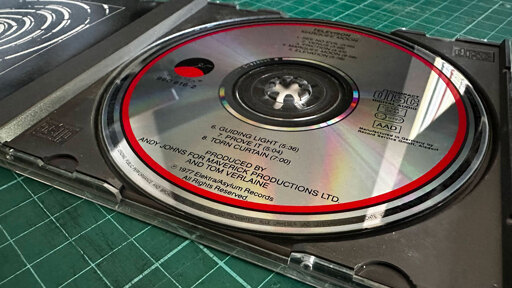I knew they were from the 80s. I did not think they came out before '88-'89 though.
I remember when the CD was relatively new. And they were still writing the standards for it. Red Book is the standard for CDs. Philips, Sony, and the others went to the record companies and they negotiated quality vs storage amounts. The quality the music industry demanded would have allowed about 8 minutes per disc. The compromise got that up to 80 minutes. Now, CDs have pretty good quality audio. For a while we said “CD quality audio” and that meant something, largely in gaming, but also in streaming later to differentiate from lossy audio (that, to most of us, sounded the same). Later we’d surpass “CD quality audio” (e.g. Dolby Atmos on Apple Music… though, not everyone agrees spatial audio is an improvement) but for a decade or two, it meant something.
Anyway, my first CDs were “Bat Out of Hell II: Back Into Hell” by Meat Loaf, and yes, I understand what he won’t do for love. I don’t know why this was ever questioned. Certainly not by anyone who listened to the song. He said he wouldn’t move on after she died. Because the fictional version of him talking was this immortal type, like a benign vampire or something. She made him promise that when she died, he’d move on and find someone else. That was where he drew the line. It’s literally right there in the lyrics and it isn’t hard to understand. The others were the Bodyguard soundtrack (so, mostly Whitney Houston), and “No More Tears” by Ozzy Osbourne. So, early 1990s. CDs had been out for a while, but I was happy with tapes for some years before I got a CD player. And, fun fact, I at least had the Meat Loaf CD for a while before I got my first CD player. I just kept it in a drawer until I could play it.
I also associate CDs with the 90s. My first portable audio player (what an archaic concept) was one of the last popular Walkman models.
Parents soon got me a Discman, which seemed liked a massive upgrade.
I don’t think I ever had a Discman until I bought myself the $150 Philips model that also played MP3 CDs. It was a fine CD player with good anti-skip, but you “only” had 80 minutes per disc.
With MP3 CDs, you could have several albums up there and the quality seemed to be about the same. The organisation was not so great and it was hit or miss what album number your albums would be (and I think it could change from day to day, so it wasn’t like you could Sharpie it on the disc), but the anti-skip became nearly perfect as most of the song would be played from the buffer. I think (but I’m not sure) that made it spin less and thus, saved battery life. Makes sense anyway.
MP3 CDs (and later iRiver DAPs) were definitely a bigger jump than cassettes to CDs, but CDs were also pretty impressive (you skips between tracks relatively quickly, quality was noticeable better).
And a few of them weren’t AOL.
Prior to CDs, AOL shipped 3.5" microfloppies. These sometimes got erased and used as free storage.
kagis
Apparently people are still selling them, decades later. Honestly, I don’t even know if, in 2025, you can read a 3.5" microfloppy that was last written in the 1990s.
kagis
https://www.arcserve.com/blog/data-storage-lifespans-how-long-will-media-really-last
Some manufacturers claimed the lifespan of floppy disks was three to five years, while others said they could last ten to twenty years. Of course, since floppy disks utilize magnetic storage (not unlike tape), it’s safe to say that eventually, the magnetism will wear out around the same time a tape would (ten to twenty years).
I’m kind of surprised that I’m not turning up harder information on longevity, but that sounds plausible to me. Note that they aren’t mentioning the capacity that the disk was initialized for — it was possible to, given a drive and disk that supported a higher capacity, to initialize for lower capacity. I don’t know if doing that might extend longevity. But I’d be a little skeptical that the actual contents of the disk are readable today.
I’ve never heard anyone call 3.5" discs, microfloppies. They are just floppies, despite not being the original size or even floppy anymore.
Get off my lawn, whippersnappers. shakes fist
https://en.wikipedia.org/wiki/Floppy_disk
In 1984, IBM introduced with its PC/AT the 1.2 MB (1,228,800 bytes) dual-sided 5¼-inch floppy disk, but it never became very popular. IBM started using the 720 KB double density 3½-inch microfloppy disk on its Convertible laptop computer in 1986 and the 1.44 MB (1,474,560 bytes) high-density version with the IBM Personal System/2 (PS/2) line in 1987. These disk drives could be added to older PC models.
My gf calls me a 3.5" microfloppy :/
Yea, but that’s warranted.
Duh, everyone knows they’re called save icons.
“I want a number four, number six, and throw in a plastic doughnut…”
I wish I remembered what my first CD was.
I think my first computer CD was a collection of DOS game (“50 in 1” pirate CDs with DOS games from 1990 to 1995 or so).
Talking Heads: Stop Making Sense
Still a banger.
My parents bought an Eric Clapton CD as their first one. I can’t remember what my first CD was, though. However, I do remember exploiting the shit out of Columbia Music for free CDs.
My first CD was Aerosmith, the one with their nipples on the cover LOL!
Good CD, though I forget the album title right now…
Robyn Hitchcock, Globe of Frogs
Mine was Suede by Suede.
My dad used to make those types of CDs. I remember one with 200 games on it. The first time I saw a non-pirated CD was MK Tilogy and I thought what a waste to use up a whole CD for just one 30MB game.
Mine was Crowded House.
Marquee Moon rules, love that album






